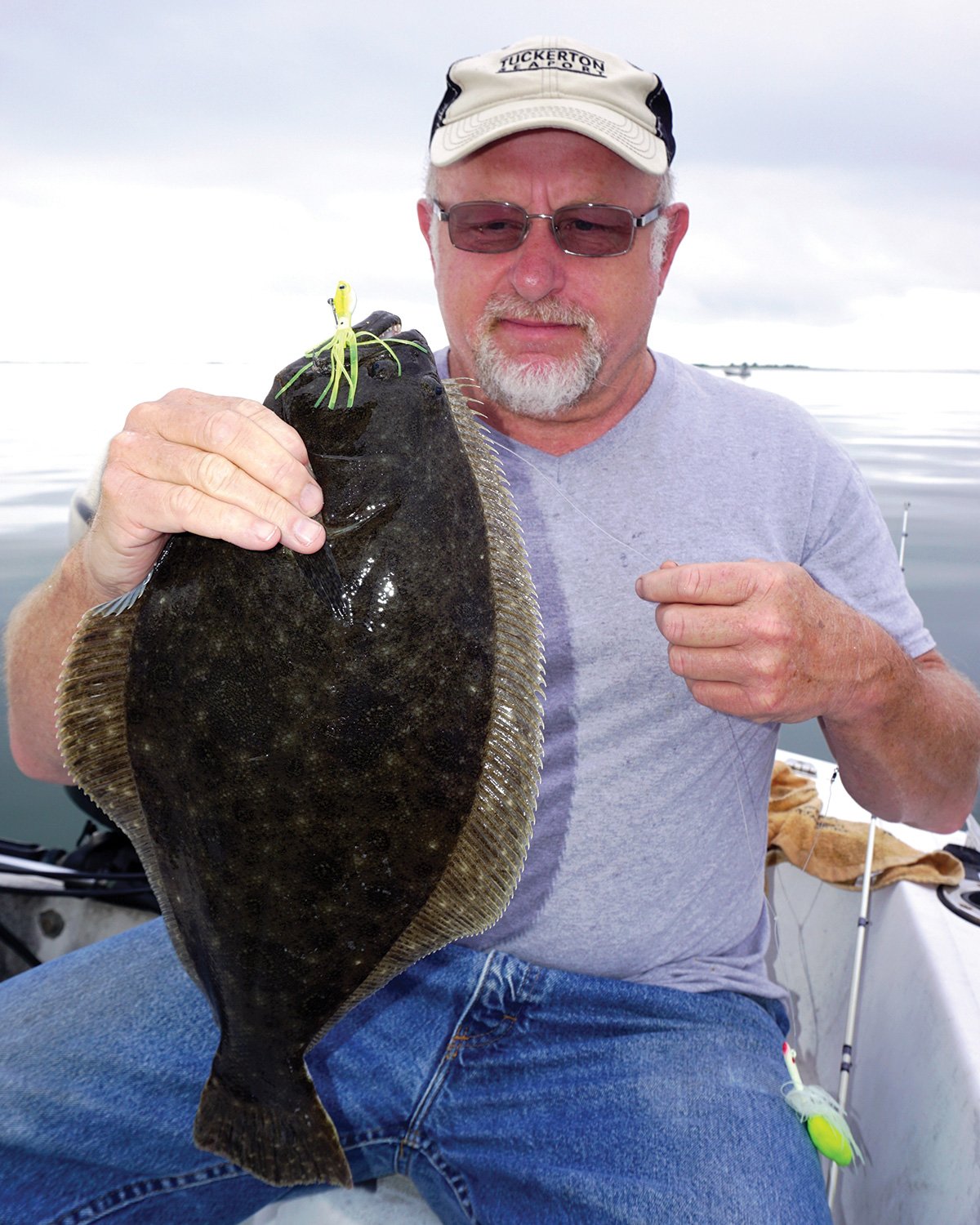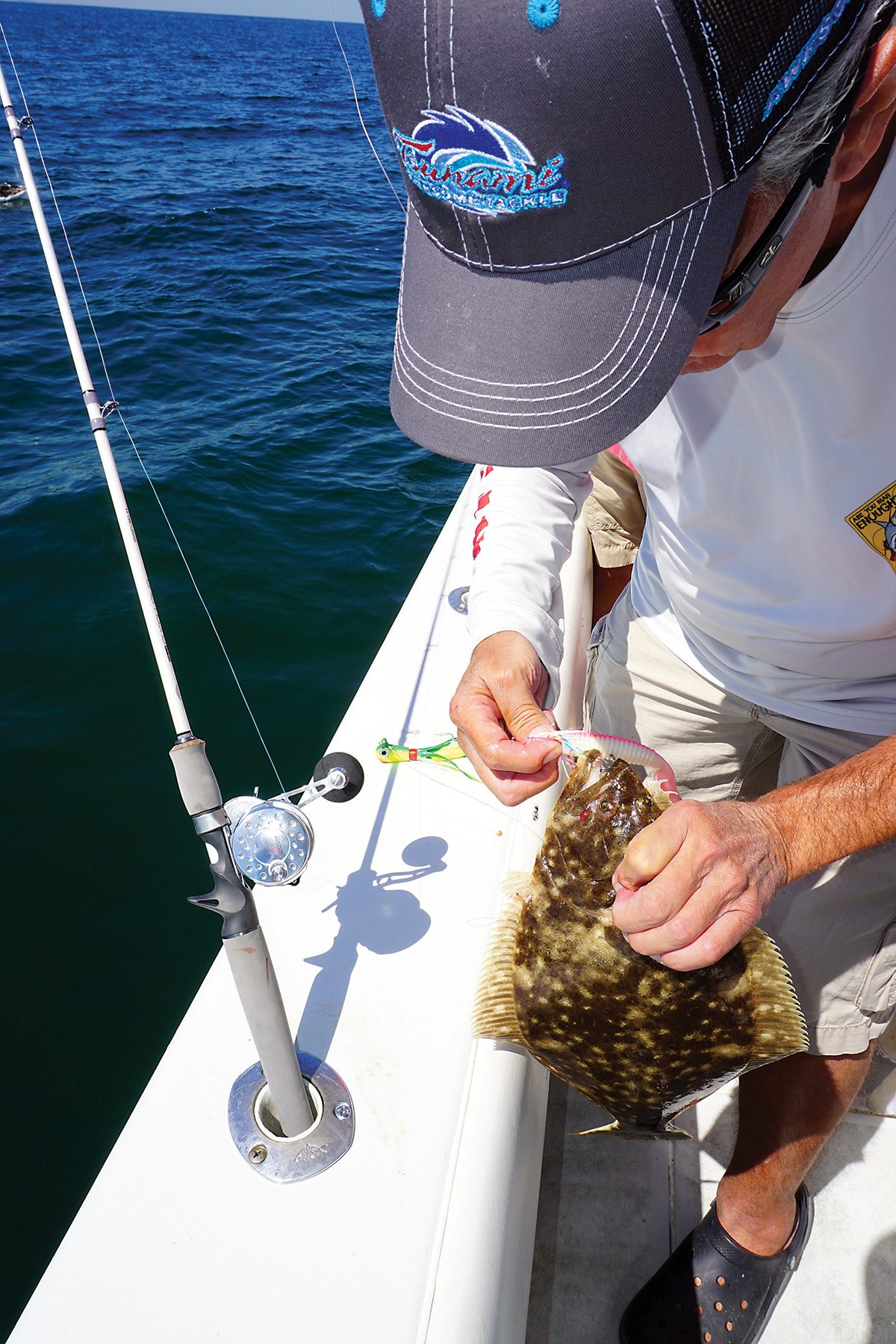
Just because New Jersey’s fluke season wasn’t open prior to May 25, didn’t mean the doormats weren’t already there waiting!
We received the first fluke photos of the year from readers along the Raritan, Barnegat and back bays of Cape May County in late April fishing for stripers and weakfish. By the first of May, pontoon boats in particular like the Highroller fishing for bluefish behind Atlantic City and Fish Finder II out of Margate reported significant fluke bycatch fishing the back waters for blues. With bycatch of course, comes mortality, which is something science is hoping to address!
In February when fluke quotas were still being hammered out I had contacted a commercial fisherman from Barnegat Light who described summer flounder as fairly well spread out along the offshore grounds. “We haven’t had too many major storms this winter. I think that makes a difference,” the skipper told me, explaining how big offshore storms over the winter push those fish farther north up to Hudson and Block Canyons. “Out of reach and less chance for them to settle back inshore to New Jersey,” he added.
While I personally go into every season with more optimism than the typical angler – somewhat of an occupational hazard – most signs point to a darn good fluke season. While there are some who believed cold water would hamper the return of the big fluke into the back bays, it’s entirely possible that the cooler spring had a more positive impact on overall water quality, perhaps even slowing down the arrival of marauding schools of bluefish.
Another cause for optimism may be the sheer volume of menhaden in the back bays this spring; while heavy presence of sand eels offshore in 2017 is thought to have kept a lot of fluke offshore last year, more inshore bunker could help usher in a banner class of fish in 2018.
Light Is Right
I find it’s a good bet to find fish in the early part of the season along shallow, nutrient rich flats where water is apt to warm quickly. Any location where good hard clam beds can be found, especially where clammers may be working the bay bottom, is worth your attention. The biggest fluke of the year, typically females over the legal size limit, are quite often first to arrive, and they’ll set up outside of creek mouths and along the edge of grassy flats to take advantage of the best food supply. When ocean water temperatures are still on the cool side, shallower water in the back tends to warm more quickly and provides better action.
Working shallower waters in the back means you can and should get away with much lighter gear. A 3000 series spinning reel or palm-size conventional (low profile) spooled with 15-pound braid is great. Lighter line of course lets you practically feel a fish’s whisper, and allows you to use the lightest jigheads and bucktails possible. In terms of the rod, I’ve grown partial to the Tsunami Slimwave; super-light rods from 6 to 7 feet in length that really help telegraph every touch from the connection through the braid and down through the guides.
I’ll attach the main line to a very small barrel, and go with a fluoro leader of 20- to 25-pound test. If using pre-packaged rigs, go easy on the bells, blades and beads. Last spring and early summer, I did well in 4 to 8 feet of water using the lightest SPRO or S&S bucktails I could get away with, tipped with long 4- to 6-inch strips of squid soaked in Fin-Essence shedder oil. On a dropper above, try a light jighead or Tsunami Glass Minnow with a Gulp! Swimming Mullet (Switch back and forth between smaller Gulp! and vary colors until something works.). Occasionally when the wind is dead and the gnats and greenheads are more active than the tide, I switch over to a light tackle spin outfit to cast a light bucktail or jighead around and cover more bottom.
This type of back country fishing from Barnegat Bay south to Grassy or Jarvis Sound behind Cape May is often outstanding starting in late April and early May, though folks could probably find similar action along the Navesink and up along the Keyport Flats too.
Outlook is Good
Dr. Ken Able, Director of Rutgers University Marine Field Station has done extensive research over the years on summer flounder migrations in and out of Great Bay. Some of his previous studies found that ultrasonically tagged fish sometimes return as early as March, primarily utilizing the lower bay close to the ocean inlet. In studies between 2003 and 2005 in particular, the more mobile fish moved along the ICW in Great Bay numerous times in a single season, while others moved up the bay and into the river when salinity was higher than average. Tagged fish however typically used the deeper bay areas with high, stable levels of dissolved oxygen and temperature, and while fluke tended to stay in rather small areas for an entire tide, they were also in motion 74 percent of the time.
In past research, the Rutgers Marine Field team found that fluke stay inside Great Bay on average for 86 days, with most tagged fish leaving the estuary between July and September, although departure may last into December and appears influenced by several factors. “In July 2004, more tagged fish emigrated, at increased rates of movement, at low barometric pressure during a storm event,” Dr. Able noted in a paper with fellow researchers Dana K. Sackett and Thomas Grothues, adding that emigration of fluke each season may be associated with big coastal storms as well as dissolved oxygen and temperature on a seasonal scale.
“With regard to the prospects for 2018, as you know, it is hard to predict,” Dr. Able told me in May when I inquired of a seasonal forecast. Having monitored larvae coming into Little Egg Inlet once a week for the past 29 years on night flood tides, the Rutgers research team hasn’t had time to sort all the recent samples just yet, but a quick scan by Dr. Able suggested there are quite a few larvae in the samples from last fall through early spring, a lot more than there were when the stocks were depleted in the ‘90s and early 2000s.
“These larvae, which come in about one-half inch in length will start growing very fast beginning now, as the water temperatures warm, and could reach about 10 inches by September,” Dr. Abel added.
Deep channels and holes may be likely sweet spots for doormats as waters warm into July, but don’t discount those channel edges and flats, especially as you get nearer the inlets. Remember too that science tells us bigger fluke tend to stay together, and they stay on the move but typically remain in one particular area through any given tide. If you hit a good fish, keep working that area!
Sexing Summer Flounder
The science of summer flounder continues to evolve, with new research coming out on a regular basis. Over the past few years, researchers from Rutgers University, including Jason M. Morson, Daphne Munroe, Ryan Harner, and Rachel Marshall have been working on evaluating the potential for a “sex-balanced harvest” approach in the recreational summer flounder fishery. That particular balancing act is essentially focused on the fact that female fluke grow larger and faster than their male counterparts, which results in recreational landings made up primarily (roughly 90 percent) of big old, fat, fecund, female fish, or BOFFFF.
Dr. Morson and his team have been evaluating the potential for slot limits in an effort to produce a more “sex-balanced” harvest in the recreational fluke fishery. By sampling landed and discarded fish on select party boats from New Jersey to Rhode Island during the 2016 season, researchers were able to examine the performance of a wide array of slot limits to figure out which might provide the best balance of harvest between smaller males and larger females. In the final analysis, the study determined that slot limits in the recreational fluke fishery could meet multiple management objectives, including conservation of female biomass.
“If we were ever going to be looking at a slot limit for management, which I think we should, it will require a lot of more thinking about how we implement that across different regions,” Morson told me by phone, adding “if you’re concerned that most of the recreational mortality is being directed at females, slot limits can help redirect effort.”
He did caution however that a one size fits all approach to a fluke slot does not necessarily mesh along the entire fluke management region from North Carolina to Massachusetts. “The catch composition is so varied up and down the coast,” Morson explained, adding what works on Delaware Bay might not work along the Raritan, much less Block Island Sound. While slot limits would help limit mortality rates on smaller male fluke, it would provide more protection for BOFFFFs. As an alternative management approach to traditional minimum size limits, the slot limit concept also has the potential to increase overall landings.
Devising and implementing such slot limits in the fluke fishery is tantamount to incorporating “alternative management approaches” in the fishery, which in part could require an act of Congress. Currently, the recreational fishing industry including groups like the Recreational Fishing Alliance (RFA), American Sportfishing Association and National Marine Manufacturers Association are rallying support on Capitol Hill to reform the federal fisheries law to allow for alternative management. While the current law does not specifically prohibit such efforts, RFA’s Jim Donofrio said a congressional directive to the National Marine Fisheries Service (NMFS) and regional fishery councils under federal law could provide more reasoned federal response.

“If they make it law, guess what, they have to consider it,” Donofrio said in February during a fluke research meeting held in Shark River.
Summer flounder is currently in a benchmark assessment year, the term “benchmark” meaning that NMFS is open to new data and modeling information, precisely where this incredible research funded by the Save the Summer Flounder Fishery Fund (SSFFF) comes into play. Hopefully, new sex-specific modeling information now being compiled by Dr. Patrick Sullivan of Cornell University can be integrated into the final benchmark to help provide a more scientifically accurate snapshot of fluke biomass as of 2019.
As for the tendencies of male and female fluke in their migration patterns along the coast, information gleaned from years of research provide a lot of hypothetical analysis, nothing concrete. Morson for example says research seems to show a better mix of females and males when they encounter smaller fish, whereas at larger sizes they were mostly females. “The hypothesis is that when the fish move inshore, in terms of the bigger fish, it’s just the female fish. If the males come inshore, they may come in fast and move out fast,” he said.
No one really knows for sure; not yet anyway. The invaluable SSFFF work has just scratched the surface.
“We didn’t tag fish to monitor movement of sexed fish,” Morson said, explaining that’s something that he and fellow researchers would like to try in the future, one of the inherent benefits of working in science. “If you’re doing good work, it should always generate more questions.”




